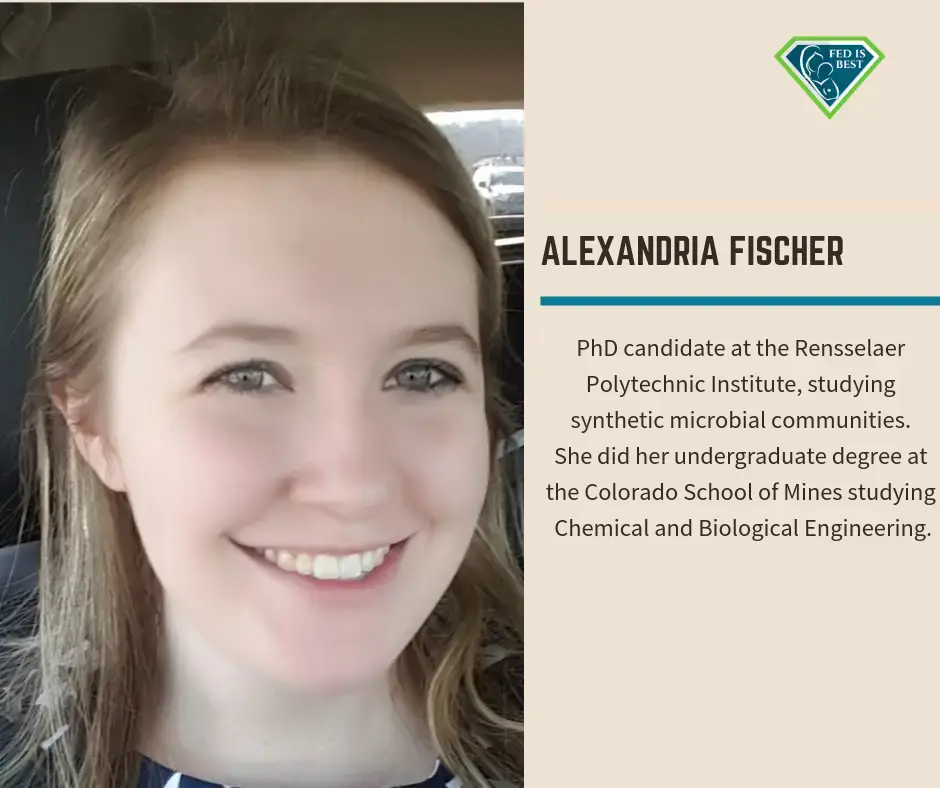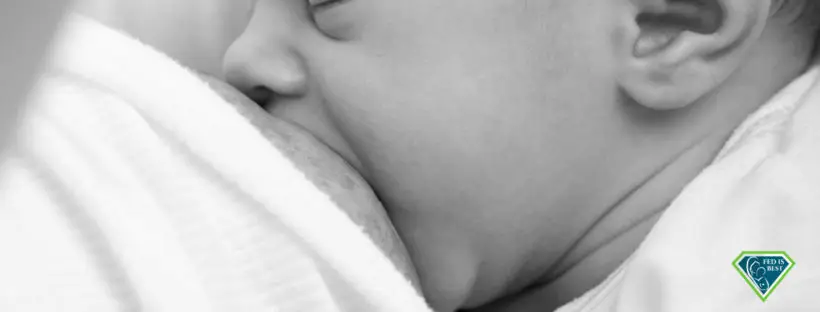by Alexandria Fischer, PhD candidate at the Rensselaer Polytechnic Institute, studying synthetic microbial communities
It’s a mantra we have all heard, on repeat. “Breast is best.” But what does that really mean? Moms are bombarded by messages about the benefits of breastfeeding, such as increased intelligence, less illnesses, and a decreased risk of cancer. But what mothers are not told, is the quantifiable proof of these benefits.
The paper “Is the “breast is best” mantra an oversimplification?“, published in the Journal of Family Practice in July 2018, sought to critically evaluate claims of breastfeeding benefits in an effort to truly understand them. These authors note that the same data has produced a wide range of conclusions about the reported benefits of breastfeeding. They sought to tease apart what variables were truly impacted, and which were not. In this review the authors determined the number needed to treat (NNT) for a myriad of health issues that are often claimed to be reduced by breastfeeding. The NNT simply means how many babies need to be breastfed in order for one baby to benefit. We need to use caution when examining NNTs because they cannot make a causal determination, meaning they cannot be used to say “breastfeeding prevented this infection” they are simply used to determine a correlative relationship.
“The NNT (numbers needed to treat) simply means how many babies need to be breastfed in order for one baby to benefit.”
Since this article was a review of data already available, we know that confounding factors (factors that may influence outcomes outside of the desired variable) are often not accounted for. Knowing this, we can determine that the NNTs determined in this study may be an overestimation of the actual correlation between breastfeeding and health outcomes.
What are the Benefits of Breastfeeding?
Below I have summarized the NNTs found in this study:
- 2 or 3 babies need to be breastfed to prevent 1 ear infection before two years of age. After 2, this effect disappears.
- 6-7 babies need to be breastfed to prevent 1 upper respiratory infection
- 25 babies need to be breastfed to prevent 1 lower respiratory infection
- 4-30 babies need to be breastfed to prevent 1 gastrointestinal infection in infants younger than 12 months. (This range is large due to discrepancies in the incidence of GI disease, thought to have changed due to the introduction of the rotavirus vaccine).
- 171 babies need to be breastfed to prevent 1 hospitalization from GI infection
- 115 babies need to be breastfed to prevent 1 hospitalization from lower respiratory tract infection (this number is noted to have a high likelihood of overestimation due to confounding factors).
- 25 babies need to be breastfed to prevent 1 case of Necrotizing enterocolitis in preterm infants
- The SIDS studies were poorly performed in terms of considering confounding factors, but even with this overestimation the data suggest that 3500 babies need to be breastfed in order to prevent 1 case of SIDS.
- 12,500 babies would need to be breastfed in order to prevent 1 case of childhood leukemia
In terms of allergic disease, the numbers come from data that is poorly controlled and suffers from publication bias. The authors note that these numbers may only apply if there is a family history of each disease. But, if we accept these conditions
-
-
-
- 76 babies need to be breastfed to prevent 1 case of asthma
- 36 for 1 case of eczema in the first 2 years
- 54-70 for 1 case of allergic rhinitis
-
-
The authors found no evidence that breastfeeding protects against
-
-
-
- food allergies
- dental problems
- hypertension
- type 2 diabetes
- high cholesterol
- growth
- and death
-
-
Authors noted a small, but clinically insignificant increase in IQ, for an unknown duration, indicating that breastfeeding does not make children smarter.
What do these numbers tell us? What should we draw from them? That the number of babies that need to be exclusively breastfed to benefit one baby is often quite high especially for the most significant claims made (SIDS and leukemia). We can also note that many of these findings come from studies with poor controls (meaning confounding factors were not examined) and that a large number of claims of health benefits have no evidentiary basis.
What About the Harms?
This study also examined the numbers of babies harmed by exclusive breastfeeding. A summary of those findings are shown below. The number needed to harm or NNH, tells us how many babies need to be breastfed to harm one baby.
-
-
-
- Late preterm babies (34-36 weeks) are also found to be twice as likely to be readmitted to the hospital from exclusive breastfeeding complications due to insufficient milk intake, as compared to their formula fed counterparts.
-
-
Even in term infants “exclusive breastfeeding at discharge from hospital is likely the single greatest risk factor for hospital readmission in newborns.” These readmissions are due to hyperbilirubinemia, dehydration, hypernatremia and hypoglycemia from inadequate breast milk intake.
-
-
-
- For every 77 babies breastfed, 1 is readmitted to the hospital for hyperbilirubinemia, dehydration, hypernatremia, or weight loss.
- For every 13 babies breastfed, 1 has a weight loss of greater than 10%. These numbers are striking because they illustrate what mothers are not told, that exclusive breastfeeding carries risks.
-
-
The authors then talk about where all of this data comes from. The studies are often severely limited, the vast majority of these limitations tend to overestimate the benefits of breastfeeding. Since breastfeeding rates are strongly patterned with socioeconomic status, race, and education levels, all of which are strongly tied with improved health outcomes both in the long and short term, we can conclude that any study that does not control for confounding factors such as these will overestimate any purported benefits. These studies are also observational only, thus causality cannot be determined and the studies can suffer from self-selection and recall bias, limiting the strength of the data they collect and the conclusions they draw from it.
“Exclusive breastfeeding at discharge from hospital is likely the single greatest risk factor for hospital readmission in newborns.”
Finally, the risks of breastfeeding are discussed. The authors note that there is not a lot in the way of data in terms of harms of breastfeeding advocacy, even though the results of these harms are seen in the small amount of data we do have. These risks include hospital readmission due to:
-
-
-
- underfeeding and dehydration
- Sudden Unexpected Postnatal Collapse (accidental suffocation) from unsafe sleep arrangements (i.e. co-sleeping during breastfeeding).
- banning pacifier use given that pacifier use has been correlated with reduced SIDS rates with a NNT of 2733 babies using a pacifier before last sleep to prevent 1 SIDS incident, which makes it a more effective preventative measure than breastfeeding.
- the emotional toll on some women caused by strain and anxiety related to breastfeeding as well as guilt if they are unable to breastfeed.
- underfeeding and dehydration
-
-
So, is breast best? This study seems to suggest it is far more nuanced than simply a “one or the other” choice. These authors call for a more rigorous examination of the risks of breastfeeding as well as shifting the conversation from overstated benefits of breastfeeding to a conversation about what is best for an individual mother/baby dyad depending on their own personal circumstances.

Alexandria Fischer is a PhD candidate at the Rensselaer Polytechnic Institute, studying synthetic microbial communities. She obtained her undergraduate degree at the Colorado School of Mines studying Chemical and Biological Engineering. Alexandria came to know the Fed is Best Foundation when struggling to breastfeed her daughter. There she learned that many of the benefits of breastfeeding are vastly overstated and became a part of the advisory team. As a scientist, she is passionate about communicating science to the general public in an approachable and accurate way. She uses her scientific training to evaluate current infant feeding research for strengths and weaknesses, helping to dispel misinformation commonly circulated in the discourse surrounding breastfeeding.
From Fed is Best:
The good news is that the risks of exclusive breastfeeding discussed above can easily be eliminated with timely supplementation if breastfeeding is insufficient, safe positioning while breastfeeding and doing skin-to-skin, and having nurseries for mothers when they are not able to safely care for their babies .
Additional information about the risks, read the article, “Baby-Friendly Hospitals Can, Paradoxically, Be Unsafe for Newborns.”
HOW YOU CAN SUPPORT THE FED IS BEST FOUNDATION
There are many ways you can support the mission of the Fed is Best Foundation. Please consider contributing in the following ways:
- Join the Fed is Best Volunteer group to help us reach Obstetric Health Providers to advocate for counseling of new mothers on the importance of safe infant feeding.
- Make a donation to the Fed is Best Foundation. We are using funds from donations to cover the cost of our website, our social media ads, our printing and mailing costs to reach health providers and hospitals. We do not accept donations from breast- or formula-feeding companies and 100% of your donations go toward these operational costs. All the work of the Foundation is achieved via the pro bono and volunteer work of its supporters.
- Share the stories and the message of the Fed is Best Foundation through word-of-mouth, by posting on your social media page and by sending our resources to expectant moms that you know. Share the Fed is Best campaign letter with everyone you know.
- Write a letter to your health providers and hospitals about the Fed is Best Foundation. Write them about feeding complications your child may have experienced.
- Print out our letter to obstetric providers and mail them to your local obstetricians, midwives, family practitioners who provide obstetric care and hospitals.
- Write your local elected officials about what is happening to newborn babies in hospitals and ask for legal protection of newborn babies from underfeeding and of mother’s rights to honest informed consent on the risks of insufficient feeding of breastfed babies.
- Send us your stories. Share with us your successes, your struggles and everything in between. Every story saves another child from experiencing the same and teaches another mom how to safely feed her baby. Every voice contributes to change.
- Send us messages of support. We work every single day to make infant feeding safe and supportive of every mother and child. Your messages of support keep us all going. Thank you for your advocacy!

9 thoughts on “An Evaluation Of The Real Benefits And Risks Of Exclusive Breastfeeding.”